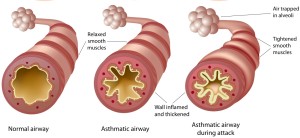Both asthma and obesity have surged in recent decades, and a growing body of literature is linking the two conditions. Various explanations have been proposed: One recent study suggests that hormonal factors in obesity may regulate airway diameter; another suggests that obesity activates asthma-related genes.
“Why obesity predisposes a person to asthma has been a real puzzle,” says Dale Umetsu, MD, PhD, who recently researched the problem with Hye Young Kim, PhD, and other colleagues in the Division of Allergy and Immunology at Boston Children’s Hospital. “Our goal was to find the connection between these two problems, which occur in both children and adults, and to explore possible new treatments.”
The team’s research indicates that obesity alters the innate immune system—the body’s first responder to infection—in several ways, resulting in lung inflammation. Published earlier this month in Nature Medicine, their work also suggests a completely new, “druggable” approach to treating patients with obesity-associated asthma, for whom standard asthma drugs often work poorly.
Results in rodents
The researchers studied groups of mice that were fed a high-fat diet for 14 weeks, causing them to become obese. Unlike the mice fed with normal diets, the obese mice developed airway hyperreactivity (constricted, twitchy airways), asthma’s cardinal feature. The lungs of these mice had several features that set them apart from the non-obese mice:
- high levels of the protein interleukin 17A (IL17A), a signaling molecule associated with several inflammatory conditions
- increased numbers of the immune cells that produce IL17A, known as type3 innate lymphoid cells (ILC3 cells)
- activation of an inflammatory protein known as NLRP3 inside lung cells
- increased production of the cytokine IL-1β, a stimulator of ILC3 cells
When the obese mice were rendered unable to produce IL17A or NLRP3 through genetic tinkering, they didn’t develop asthma. But when the same mice had IL-1β or ILC3 cells placed directly in their lungs, either was enough to spur production of IL7A and to cause asthma symptoms.
“This inflammatory pathway to asthma previously had not been recognized,” says Umetsu, who recently left Boston Children’s to become principal medical director at Genentech (not a supporter of this study). “It may be resistant to standard asthma medications such as corticosteroids.”
But the team found it did succumb to another existing drug, at least in the obese mice. When IL-1β production was blocked with the rheumatoid arthritis drug anakinra (marketed by Swedish Orphan Biovitrum AB under the brand name Kineret), the mice remained asthma-free.
Human connection
Do these results mean anything for people? Umetsu notes some circumstantial evidence. Obese people have previously been reported to have elevated blood levels of IL-17 and IL-1β, particularly those who have non-allergic asthma. While Umetsu and his team were unable to study human patients directly, they did examine lung fluid from 10 patients with lung disease who underwent bronchoalveolar lavage, a diagnostic test. The patients with severe asthma had increased numbers of ILC3 cells producing IL-17 as compared to those with mild asthma or no asthma; how they might respond to an IL-1β blocker is unknown.
“Future studies will focus on studying these cells in greater detail, and determining whether they are important in other respiratory conditions,” says Umetsu.








